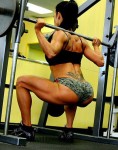Training the Glutes for Balanced Development
The gluteus maximus is a badly misunderstood creature. Most women go out of their way to avoid doing anything to work their butt to prevent it growing and most men ignore it because they tend to get caught up up in admiring the mirror muscles and anything beyond biceps and pectorals gets little consideration. This is unfortunate for all trainers regardless of goal.
The Glutes and Injury Prevention
The most significant role of glute work (actually composed of gluteus maximus, minimus and medius) is in injury prevention. An injured athlete is not training at all. Given the amount of people who spend a large part of their lives with some sort of hip or lower back pain, adding an exercise or two for the gluteus muscles seems like a good return on investment.
It is unfortunate that most of those who suffer from problems in the lower back area do not consider the importance of strong,healthy gluteal muscles. Simply put, when these muscles are under-developed (and this is the case in a huge majority of individuals in Western societies), the body attempts to compensate by allowing an increased range of motion in the lower vertebrae and using the spinal erectors (the muscles around the spine) to do the work of the glutes. Witness the huge number of people who have flat bottoms rather than a well-developed gluteus maximus to have an idea of those who are walking around with back pain
So why is this? It is mainly linked to modern life. Observing how the majority of people walk today in shoes with thick, padded soles should provide ample evidence. Most people will walk very upright (or even leaning back slightly) and with little to no glute activation. Given that an overwhelming number people don’t train the glutes either, this leads to virtually zero work for the glutes, muscle atrophy, and the beginning of lower back and hip pains through over-compensation.
Burning Fat and Building Muscle
Beyond injury prevention, glute training is also important for those who are looking to burn fat, build muscle, get stronger or a combination of all three. Clearly, developing a shapely butt is going to be a priority for anyone training simply for appearance’s sake. Given that the glute group of muscles constitutes the biggest group in the body behind the muscles of the back, increasing its size means that resting metabolic rate will also increase, burning more calories at rest. This is great for anyone who is attempting to get lean, which is actually most people most of the time. Finally, for strength athletes, glute training is a must. Learning how to activate glutes efficiently will immediately lead to more weight on the bar in squats and deadlifts which clearly means more strength and therefore greater muscle mass.
Glute Activation Exercises
Given all these advantages, it is reasonable to wonder how to incorporate glute training into a routine. There are many simple methods, but here are three to get started.
Sprints
Sprinting is a great activity for increased glute activation as can be witnessed by looking at any top level sprinter. Doing two sessions of repetition hill sprints every week will certainly make a significant difference to muscular development in this area.
The Glute Bridge
This is another great exercise because it can evolve to challenge anyone from an untrained beginner to a powerlifter. Going from body weight all the way up to a heavy barbell will keep this effective for everyone.
Squats
Squats have received a bad reputation in some parts, mainly through ignorance, but this is a great choice for improving glute strength. Again this can be done from bodyweight upwards to provide a challenge.
Glutes training doesn’t have to be complicated, but it is important for everyone. The benefits for strength athletes all the way down to those who would rather avoid hip and back pain are clear and the time it takes to do make a worthwhile addition to anyone’s schedule.
Related posts
11889 total views, 7 today






